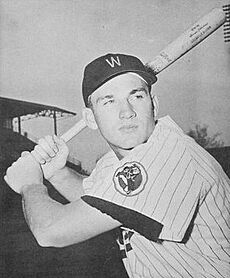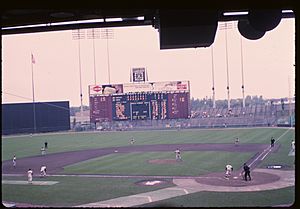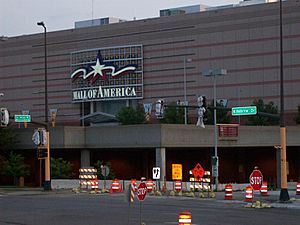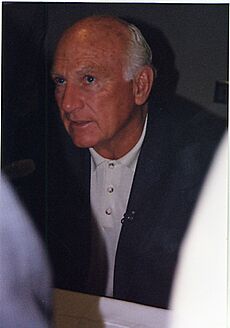Harmon Killebrew facts for kids
Quick facts for kids Harmon Killebrew |
|||
|---|---|---|---|
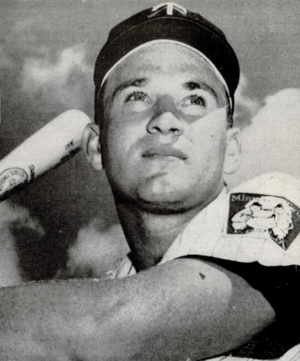
Killebrew with the Minnesota Twins in 1962
|
|||
| First baseman / Third baseman / Left fielder | |||
| Born: June 29, 1936 Payette, Idaho, U.S. |
|||
| Died: May 17, 2011 (aged 74) Scottsdale, Arizona, U.S. |
|||
|
|||
| debut | |||
| June 23, 1954, for the Washington Senators | |||
| Last appearance | |||
| September 26, 1975, for the Kansas City Royals | |||
| MLB statistics | |||
| Batting average | .256 | ||
| Hits | 2,086 | ||
| Home runs | 573 | ||
| Runs batted in | 1,584 | ||
| Teams | |||
|
|||
| Career highlights and awards | |||
|
|||
| Induction | 1984 | ||
| Vote | 83.1% (fourth ballot) | ||
Harmon Clayton Killebrew Jr. (born June 29, 1936 – died May 17, 2011) was a famous American professional baseball player. People called him "the Killer" or "Hammerin' Harmon". He played most of his 22-year career in Major League Baseball (MLB) for the Minnesota Twins.
Harmon Killebrew was a very strong power hitter. When he retired, he had the fifth-most home runs in MLB history. He was second only to Babe Ruth in American League (AL) home runs. He was also the AL career leader in home runs for a right-handed batter. Killebrew was added to the National Baseball Hall of Fame in 1984.
Killebrew was 5 feet 11 inches (180 cm) tall and weighed 213 pounds (97 kg). His powerful swing helped him hit many home runs. He was one of the most feared power hitters in the 1960s. During that time, he hit at least 40 home runs in eight different seasons. Overall, Killebrew led the league in home runs six times. He also led in RBIs three times. He was chosen for the All-Star team 13 times.
In 1965, he played in the World Series with the Twins. They lost to the Los Angeles Dodgers. His best season was 1969. That year, he hit 49 home runs and had 140 RBIs. He also won the AL Most Valuable Player Award. He helped the Twins win the AL West pennant.
Killebrew was known for hitting home runs very far. He hit the longest home runs ever recorded at Minnesota's Metropolitan Stadium (520 feet) and Baltimore's Memorial Stadium (471 feet). He was also the first of only four players to hit a ball over the left field roof at Detroit's Tiger Stadium. Even with his powerful nicknames, Killebrew was a quiet and kind person.
After he stopped playing baseball, Killebrew worked as a television announcer for several baseball teams from 1976 to 1988. He also taught players how to hit for the Oakland Athletics.
Contents
Harmon Killebrew's Early Life
Killebrew was born and grew up in Payette, Idaho. He was the youngest of four children. His father, Harmon Clayton Sr., was a painter and a sheriff. His father had been a great football player in college. Harmon's grandfather was also known for being very strong. Harmon's father encouraged him and his brothers to play many sports. His father passed away in 1953.
As a child, Killebrew played baseball at Walter Johnson Memorial Field. This field was named after a famous pitcher. Harmon also worked on a farm. He lifted heavy milk cans, which helped him build strength. In high school, Killebrew earned 12 awards in different sports. He was even named an All-American quarterback in football. His high school retired his uniform number. He was offered a scholarship to play football at the University of Oregon, but he chose baseball instead.
In the early 1950s, a senator from Idaho told the owner of the Washington Senators, Clark Griffith, about Killebrew. Harmon was hitting with an amazing .847 batting average for a semi-professional team. Griffith sent his scout, Ossie Bluege, to Idaho to watch Killebrew. The Boston Red Sox were also interested. But Bluege signed Killebrew to a $50,000 contract on June 19, 1954.
Harmon Killebrew's Professional Baseball Career
Playing for the Washington Senators and Minnesota Twins (1954–1974)
Killebrew signed his contract under a special rule. This rule meant he had to spend two full seasons on the major league team. He made his MLB debut just four days after signing. He was almost 18 years old. This made him the youngest active player in the major leagues at that time.
On August 23, 1954, Killebrew started his first game. He hit two singles and a double. The Senators won that game. A year later, on June 24, 1955, Killebrew hit his first major league home run. He was almost 19. In his first two seasons, he struggled a bit. He struck out 34 times in 93 at bats. He had a .215 batting average and hit four home runs. He also had trouble playing third base.
In 1956, Killebrew was sent to a minor league team in Charlotte. He played well there. He returned to the major leagues in May. On May 29, he hit two home runs in a game against the Orioles. One of them was only the second ball ever hit over a wire barrier in Baltimore's Memorial Stadium. He was sent back to the minor leagues later that season. He finished the year in Charlotte with a .325 batting average and 15 home runs.
Killebrew spent most of 1957 with the Chattanooga Lookouts. He led the league with 29 home runs and 101 RBIs. He was named to the All-Star Game. In Chattanooga, he was the only player to hit a home run over the center field wall at Engel Stadium, which was 471 feet from home plate. In 1958, he played briefly for another minor league team before returning to Chattanooga. He also played a few games for the Senators in 1957 and 1958.
In 1959, Calvin Griffith, the new owner of the Senators, decided Killebrew was ready to be the team's main third baseman. Killebrew had a great start to the season. He had five games where he hit multiple home runs. He also had his first game with five RBIs. By mid-season, he had 28 home runs. He was chosen to start the first 1959 All-Star Game. Even President Dwight D. Eisenhower came to watch him play. Killebrew finished the season with 42 home runs. This tied the Senators' single-season record. It was his breakout season.
Killebrew had some injuries in 1960. He had surgery on his nose and missed time with a hamstring injury. But he still hit 31 home runs in 124 games. Even with Killebrew's power, the Senators usually finished near the bottom of the American League. After the 1960 season, the team moved to Minnesota and became the Minnesota Twins.
Amazing Seasons with the Twins (1961–1965)
In the Twins' first year in Minnesota, Killebrew was named team captain. He had an amazing season, hitting 46 home runs. This broke the team record he had tied two years earlier. He also had 122 RBIs, a career-best batting average of .288, and a slugging percentage over .600. He led the Twins in runs, total bases, and walks. Killebrew was chosen for both All-Star games in 1961. After the season, he won a home run hitting contest against Roger Maris, who had just broken the single-season home run record.
In 1962, Killebrew's speed started to slow down because of leg injuries. He moved to left field. He had a slow start to the season. But on July 18, Killebrew and Bob Allison made history. They became the first teammates since 1890 to hit grand slams in the same inning! Killebrew finished the season with 48 home runs, 126 RBIs, and 107 walks. These were all career highs at the time. He led the AL in home runs and RBIs. His 48 home runs broke the team record for the second year in a row. However, his batting average dropped to .243, and he struck out a career-worst 142 times.
In 1963, Killebrew signed a contract for about $40,000. He missed some time early in the season due to a knee injury. But when he returned, he continued to hit well. On September 21, Killebrew hit three home runs in one game. This was the only time he did that in his career. He finished the season with a .258 batting average, 45 home runs, and 96 RBI. He led the league in home runs and slugging percentage. He had surgery on his knee after the season.
Because of his knee surgery and a weak throwing arm, Killebrew moved from the outfield to play in the infield for the rest of his career. In 1964, he had a .270 batting average, 49 home runs, and 111 RBI. He led the AL in home runs for the third year in a row.
The Twins finally won the American League pennant in 1965. On July 11, Killebrew hit a two-run home run to win a game against the Yankees. Two days later, he started the All-Star Game at his home stadium, Metropolitan Stadium. He hit a game-tying two-run home run. Killebrew became the first player in All-Star game history to be chosen at three different positions: third base, left field, and first base.
Killebrew often hit the tying or winning run for the Twins. But on August 2, he dislocated his elbow trying to make a play. This injury kept him out until mid-September. Even without him, the Twins kept winning. Killebrew finished the season with 25 home runs and 75 RBI. These were his lowest numbers in a full season because of the injury. In the 1965 World Series against the Los Angeles Dodgers, Killebrew hit a home run. But the Dodgers won the series in seven games.
MVP Season and Later Years (1966–1974)
In 1966, Killebrew started slowly but finished strong. He hit 39 home runs and had 110 RBIs. He led the AL with 103 walks. He finished 4th in the MVP Award voting.
During the 1967 season, Killebrew hit the longest home run ever recorded at Metropolitan Stadium at that time. It was a 520-foot shot. The Twins were in the pennant race all season. They had a one-game lead going into the last two games against the Boston Red Sox. Killebrew hit a home run in the first game. But Boston won both games, and Minnesota finished tied for second place. Killebrew finished the season with a .269 batting average, 113 RBIs, and 44 home runs. He also led the league with 131 walks. He finished second in MVP voting.
In 1968, Killebrew had a tough season. His batting average was low for most of the year. Even so, he was chosen as the starting first baseman for the All-Star Game. During the game, he injured his left hamstring very badly. This injury was thought to be career-ending. But after missing about six weeks, he returned in September.
After seven months of recovery, Killebrew had his best season in 1969. On July 5, he set a career-high with six RBIs in one game. On September 7, he hit a three-run homer and a grand slam in the same game. Killebrew led the best offense in the league. The Twins, led by new manager Billy Martin, won the new American League West division.
For the season, Killebrew set career highs in RBIs (140), runs, and walks (145). He tied his career high with 49 home runs. He even stole eight bases, which was a lot for him. He won his only Most Valuable Player Award. He played in all 162 games. He led the majors in home runs and RBI. He also led the AL in on-base percentage and walks. As of 2021, his home run, RBI, and walk totals from 1969 are still team records. In the 1969 American League Championship Series, the Baltimore Orioles beat Minnesota. The Orioles often walked Killebrew to avoid pitching to him.
After his MVP season, Killebrew signed a new contract worth $90,000. He continued his success in 1970. He hit 41 home runs and had 113 RBIs. He finished third in MVP voting. The Twins again faced the Orioles in the 1970 American League Championship Series. Killebrew hit two home runs, but Minnesota was swept again.
Killebrew hit 40 home runs in a season for the last time in 1970. He also made his last appearance in the postseason. Before the 1971 season, he signed the first $100,000 contract in Twins history. Killebrew played in his last All-Star Game in 1971. He hit a two-run home run that helped the AL win. He finished the season with a .254 batting average, 114 walks, 119 RBI, and 28 home runs. He hit his 500th career home run on August 10, 1971. He was the 10th player in history to reach 500 home runs. He then hit his 501st home run later in the same game!
In 1972, Killebrew started to slow down. He missed his first All-Star Game since 1962. But he was happy that his teammate, Danny Thompson, might get a chance to play instead. Killebrew finished the season with 26 home runs and 74 RBIs. In 1973, he had more leg problems and had surgery twice. He played in only 69 games that season, hitting five home runs.
Killebrew was fully recovered for the 1974 season. On May 5, he hit two home runs, including his 550th career home run. In August, the Twins held "Harmon Killebrew Day." They announced they would retire his number. Killebrew led the Twins to a 5–4 victory that day. He finished the season with 13 home runs and 54 RBIs. In December 1974, he chose to leave the Twins after 21 seasons.
Playing for the Kansas City Royals (1975)
On January 24, 1975, Killebrew signed a one-year contract with the Kansas City Royals. When he returned to Minnesota in May, the Twins officially retired his No. 3 jersey. In that game, Killebrew hit a home run against his old team and received a standing ovation. In 106 games with the Royals, he hit 14 home runs and had 44 RBIs. At the end of the season, the Royals released him. In March 1976, he announced his retirement from baseball. At that time, he was fifth all-time on the home run list.
Harmon Killebrew's Career Highlights
Statistics and Achievements
Killebrew hit 573 home runs in his career. This ranks him 12th all-time. He also drove in 1,584 RBIs and had 1,559 walks. He holds the record for the most career home runs among players born in Idaho. He also had the most plate appearances in his career without a sacrifice hit.
| Category | G | BA | AB | R | H | 2B | 3B | HR | RBI | BB | SO | OBP | SLG | OPS | TB | PO | A | DP | E | FLD% | Ref. |
|---|---|---|---|---|---|---|---|---|---|---|---|---|---|---|---|---|---|---|---|---|---|
| Total | 2,435 | .256 | 8,147 | 1,283 | 2,086 | 290 | 24 | 573 | 1,584 | 1,559 | 1,699 | .376 | .509 | .884 | 4,143 | 8,849 | 1,963 | 767 | 215 | .981 |
Amazing Power Hitting
Killebrew was famous for his quick hands and strong upper body. This allowed him to hit many "tape measure" home runs. He said his first home run in the Majors was his favorite. The catcher, Frank House, told him what pitch was coming. Killebrew hit it out of the park. He said it was one of the longest home runs he ever hit.
On August 3, 1962, he was the first player to hit a baseball over the left field roof at Tiger Stadium. Only three other players did this in the next 37 years. On May 24, 1964, Harmon hit the longest measured home run at Baltimore's Memorial Stadium, going 471 feet. On June 3, 1967, Killebrew hit a 520-foot home run. This was the longest measured home run ever hit at Metropolitan Stadium. It is still the longest in Twins history. At the Mall of America, which is built where Metropolitan Stadium used to be, there is a plaque marking home plate. There is also a red seat placed where that famous 520-foot home run landed.
Honors and Legacy
 |
|
| Killebrew's number 3 was retired by the Minnesota Twins in 1975. |
Killebrew was first able to be voted into the Hall of Fame in 1981. He received 59.6% of the votes, but 75% is needed to get in. Even though he hit 573 home runs, some voters looked at his lower batting average (.256) and higher number of strikeouts.
In 1984, Killebrew received 83.1% of the votes. He was elected to the Hall of Fame in his fourth year of eligibility. He joined Luis Aparicio and Don Drysdale.
In 2022, The Sporting News named Killebrew as one of the "Minneapolis Mount Rushmore of Sports." This means he is considered one of the four greatest sports figures from Minneapolis.
The street along the south side of the Mall of America in Bloomington, Minnesota, is named "Killebrew Drive" in his honor. The Mall of America is built on the former site of Metropolitan Stadium. Banners inside the Metrodome used to show the retired numbers of Twins legends, including Killebrew's No. 3. In 1999, he was ranked 69th on The Sporting News list of the 100 Greatest Baseball Players. When the Twins moved to Target Field in 2010, Gate 3 was named in his honor.
Killebrew is the model for the logo of the Major League Baseball Players Alumni Association. This is an organization he helped start in 1982.
Killebrew was known as a true gentleman during his playing career. Many people said he was one of the nicest people to ever play the game. Umpire Ron Luciano wrote in his book that Killebrew would even compliment umpires on good calls, even if they went against him.
After Baseball
After retiring, Killebrew worked as a television announcer for the Twins from 1976 to 1978. He also announced for the Oakland Athletics and the California Angels. He returned to announce for the Twins from 1984 to 1988. While with Oakland, he also taught players how to hit.
Killebrew was involved in an insurance business in Idaho. He moved to Scottsdale, Arizona, in 1990. There, he led the Harmon Killebrew Foundation, which he started in 1998. Killebrew also founded a golf tournament in 1977. It is now called the Killebrew-Thompson Memorial. This tournament has raised over $23 million for leukemia and cancer research. He started it to honor his Twins teammate, Danny Thompson, who passed away from leukemia at age 29.
Personal Life
Even with his powerful nicknames, Killebrew was considered a quiet and kind man by his friends and teammates. He was a member of the Church of Jesus Christ of Latter-day Saints. When asked about his hobbies, he once joked, "Just washing the dishes, I guess."
In the late 1980s, Killebrew faced some financial difficulties. He also divorced his first wife, Elaine, whom he had married in 1955. After this, Killebrew had some serious health issues. He had several surgeries and was very ill. By December 1990, his health improved, and he married Nita Patten.
On December 29, 2010, Killebrew announced he had been diagnosed with esophageal cancer. On May 13, 2011, he decided to stop treatment. He passed away on May 17, 2011, at his home in Scottsdale at age 74. To honor him, the Twins wore special throwback jerseys for the rest of the 2011 season. The Washington Nationals also honored him. Killebrew was buried in Payette, Idaho.
After his death, the Minnesota Twins president, Dave St. Peter, said that Harmon Killebrew meant more to the Twins and their fans than anyone else. He said Harmon would always be remembered as a great home run hitter and a leader. But more importantly, he would be remembered for his kindness, dignity, and humility as a husband, father, friend, teammate, and man.
See also
 In Spanish: Harmon Killebrew para niños
In Spanish: Harmon Killebrew para niños
- Major League Baseball titles leaders
- List of Major League Baseball home run records
- List of Major League Baseball annual home run leaders
- List of Major League Baseball annual runs batted in leaders
- List of Major League Baseball career hits leaders
- List of Major League Baseball career runs batted in leaders
- List of Major League Baseball career runs scored leaders
- List of Major League Baseball career total bases leaders
- List of Major League Baseball career bases on balls leaders
- List of baseball players who went directly to Major League Baseball


